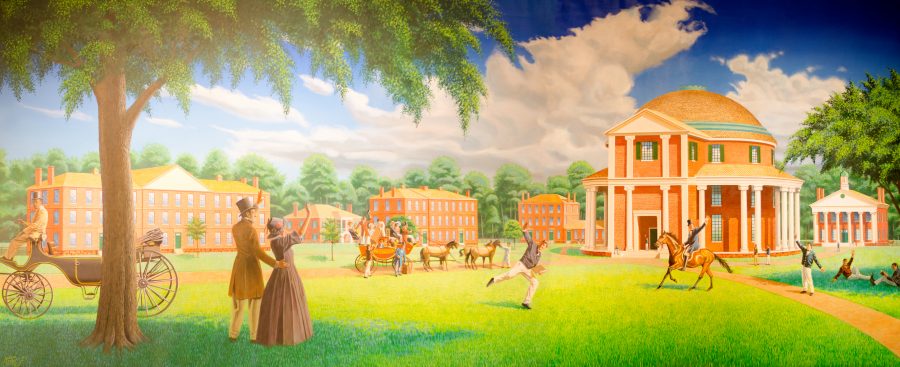Artist and historian Dean Mosher of Fairhope, Alabama, created this painting in a span of 14 months in honor of former President Judy Bonner. Using realism, the painting shows a view of the Quad – precisely how it would have looked if you were standing there in 1831.
Being not only an artist but also a historian, Mosher wanted to make sure his work accurately reflected what the original campus looked like. The painting was used with the artistic style of realism, and Mosher did an immense amount of research to make the style, locations and distance of the buildings shown in the painting as close to Alabama’s first campus possible.
“With realism, I want to find the most knowledge and be as accurate as I can before beginning the painting. If you were to be standing on the Quad and looking at this painting, I could tell you down to an inch scale where in this painting you would be,” Mosher said.
At first, Mosher had very few resources to make this painting accurate. In fact, there is only one photograph available of the original campus, which shows the original rotunda in 1859 designed by William Nichols. In order to establish the architectural style and figure out what the buildings probably would have looked like, Mosher met with Dr. Craig T. Sheldon, professor emeritus of archaeology at Auburn University, and Paul Kapp, director of the historic preservation program and associated professor at the University of Illinois’s School of Architecture.
Mosher met Dr. Kapp, who has written a book on the architecture of William Nichols, a nationally acclaimed architect of the original campus. Dr. Kapp provided the architectural research about the campus the while Dr. Sheldon provided the archaeological research.
“With some heavy communication between Dr. Kapp and Dr. Shelton, we started to put together clues of the original campus that no one had really looked at together,” Mosher said.
The original rotunda was built almost entirely using materials that were on the site, including the foundation stones which were made from the quarry near the river. Mosher met with David Hale, a global positioning expert, and Creighton “Peco” Forsman, a model maker, and discussed how the original structures were built by using these local materials. Forsman and Mosher then assembled and scaled models of a few original campus structures.
After the models were constructed, photographs and drawings were taken of these models, which were at a one-fourth inch per foot scale, and laid on top of the original photograph. This matched up perfectly and revealed where the faculty building was located.
“We found one building by two little rooflines that were almost invisible in the woods, but when we overlaid the two pictures, they matched it up perfectly. And those two rooflines revealed the faculty building,” Mosher said.
Putting together the archeology, figuring out where the foundations were located, finding the locations of each building in the painting and mapping everything out was only the first half of the project.
Every aspect of this painting is backed up with historic research, even the clothing. To draw the people in the scene, Mosher studied the clothing of the 1830s, observing how students and parents dressed. Costumes were sewn for the painting and Mosher posed people as he painted, which took many hours to complete as many factors, such as lighting and positioning, are involved.
Gabby Schaller, a freshman majoring in pre-law, noted, “The people, lighting and scenery in this painting makes the the start of UA look so exciting. The details in it are incomparable. It’s also amazing to know the tremendous research that went into this painting.”
The painting alone is so intricate and detailed, and you can’t detect all of the details until you have looked at it in person. Students are strongly encouraged to visit the Pearce Grand Foyer of the Gorgas Library to observe Dean Mosher’s phenomenal work.







